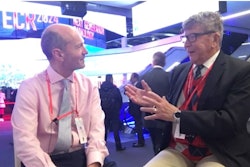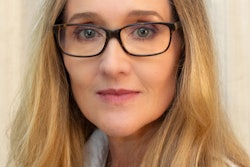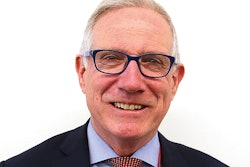In an era of dwindling resources and increasing demand, advancing radiology is not just about focusing on technology but also on people so that staff remain visible and avoid burnout. This is the view of Prof. Annemiek Snoeckx, head of radiology at Antwerp University Hospital in Belgium and chair of the European Society of Radiology (ESR) Education Committee.
In a plenary talk at ECR 2024, she flagged the "7 pillars of well-being" for how radiology staff can remain happy and effective in their profession:
 Snoeckx advocates the seven pillars of well-being model.
Snoeckx advocates the seven pillars of well-being model.
- Finding the right job – aligning one's own personal values with those of the employing organization and its culture. Snoeckx's own values are integrity and respect, and this is what she strives for in any work environment.
- The ABC of work happiness – making sure one has a sense of autonomy, belonging, and competence. This means that radiologists should feel in control, that they are part of a team or family with shared goals whose members care about each other, and that they have the skills and tools for growth and developing confidence.
- Growth opportunities – Don't hire people for the job of today but those individuals who can tackle the challenges of tomorrow. Radiologists should be in the mindset of lifelong learning.
- Workplace – Radiologists need a room with daylight, but beyond this, the workplace environment should be where colleagues respect each other and where the brain can take a rest.
- Healthy lifestyle – This involves nutrition, movement, and nature, both at home and at work. This goes beyond individual routines: The work environment should actively motivate and support healthy choices.
- Social contact – Humans are social creatures and need connection and interaction that forms the groundwork for collaboration, innovation, and resilience.
- Leadership – Choose your leaders based on emotional intelligence (EQ), not just IQ. Leadership should be about aligning people, and motivating, inspiring, and lifting them.
Above all, the profession needs to retain specialists at a time when radiologists are leaving due to work conditions or not being replaced as they retire, according to Snoeckx. Retention relies on keeping staff energetic, resilient, and motivated. This means putting well-being into the spotlight so that it will translate not just into economic gain but also gain for the patient, team, department, and employer.
"There is a leader in all of us. It's something you can learn. It doesn't need to involve big actions or fancy words, just saying to a colleague 'I really admired how you calmed down that anxious patient' can help motivate them," she noted.
Well-being may also involve a hybrid workplace, such as home reporting mixed with onsite reporting. "This mix of remote and onsite work is particularly important because what is unseen can be forgotten. We need to remain in contact with colleagues and a key partner in patient care," she told ECR attendees. "Visibility is not only important for retention but also for recruitment. With all the changing technology, we need to make the human aspect visible."
Innovation paradox
Snoeckx also pointed to how technology -- the other major element of advancing radiology -- can create solutions but also yet more challenges. During her own training, technological advances transformed workflow. By the end of her residency, the lightboxes were still on the wall, but staff used them to hang up birthday cards and post-it notes, while working on PACS workstations with efficient workflow, increased productivity, diagnostic confidence, precision through volumetric measurement, and a vast treasure trove of images for comparison.
"The idea that increased efficiency would allow for an increase in available time might have been true at first, but now the last thing that radiologists feel is that they have enough time – we are facing a lot of challenges," she said.
 Dr. Annemiek Snoeckx. Photo courtesy of ESR and Sebastian Kreuzberger.
Dr. Annemiek Snoeckx. Photo courtesy of ESR and Sebastian Kreuzberger.
These challenges reside in the very advances that aimed to provide solutions to increased demand and shrinking resources. The new technologies come with huge benefits but also a cost. Increasing computing power and software advances have reshaped cross-sectional imaging, while volumetric datasets allow postprocessing, multiplanar, functional, and molecular imaging.
"All this translates into a steady and continual increase in the number of images per study... meaning that now we only have a second to look at a cross-sectional image," Snoeckx commented.
Not only are the number of images per study on the rise but also radiologists are doing more examinations, with an increase of more than 5% per year mainly in the fields of CT and MRI. Between 2006 and 2020, on-call workload quadrupled. mainly due to CT, with a similar trend in oncological imaging.
In the future, this trend will continue: The population is growing and aging, and increasingly more people are living with a health condition, she continued. In addition, with evolving treatment and therapy, diseases that would have been fatal in the past are now becoming chronic diseases, meaning that patients are coming back for repeated imaging. Meanwhile, evolution in other fields also has its impact on imaging.
Increased workload and complexity come at a price: burnout affects the quality and safety of patient care, and it can also lead to radiologists leaving the specialty. But burnout isn't the only reason for dwindling resources, she added. European radiologists are aging in all member states, particularly in those with a high percentage of health workers over the age of 55.
"When they retire, they need to be replaced and due to current trends, one person would need to be replaced by more than one person and the staff aren't there," Snoeckx pointed out.
A shortfall in healthcare workers was forecasted by the World Health Organization in 2016. Compounding this, many people left the healthcare sector in March 2020, and since then the sector has not recovered and may never recover, she noted, adding that the mismatch therefore between dwindling resources and increasing demands is getting bigger and the challenges are becoming more problematic.
What's the impact of AI?
Snoeckx doubts that AI will provide all the solutions, given that the impact of many algorithms on patient care is as yet unproven. She noted how algorithms that boost sequences to provide shorter time frames needed for exams may mean that more exams are conducted, with consequently more data to report. She pointed to how current research indicates that most existing algorithms will increase workload in the future and will not free up the time that radiologists are desperately looking for.
"I don't want to be negative about AI ... it is the future and will reshape the profession," Snoeckx said. "The best is yet to come; it is not because these algorithms are not there yet that we will not have them in the future. AI will not just carry out routine tasks but also reporting tasks. There are algorithms out there that will create time."
Innovations initially create challenges before solutions are found, and she shared three of her own coping mechanisms: Kintsugi (the Japanese art of repairing broken pottery by mending the areas of breakage with urushi lacquer dusted or mixed with powdered gold, silver, or platinum), growth mindset, and optimism.
One evening a week, Snoeckx does pottery and tries to make a perfectly round bowl. Because her hands are dirty, she can't pick up her phone so there is a break from digital connection. She said she likes Kintsugi because it embraces and celebrates imperfections, rather than erasing the history of damage and the past.
Maintaining a growth mindset means that intelligence can be developed through embracing challenges rather than avoiding them, persisting in the face of setbacks, learning from criticism, and finding lessons of inspiration in the success of others. Such a mindset fosters resilience, mitigates burnout, nurtures lifelong learning, and helps one reach higher levels of achievement.
Finally, she encourages optimism. "In the words of Simon Sinek: Optimism is not a denial of the current state, it's a belief that the future is bright," she said.



















